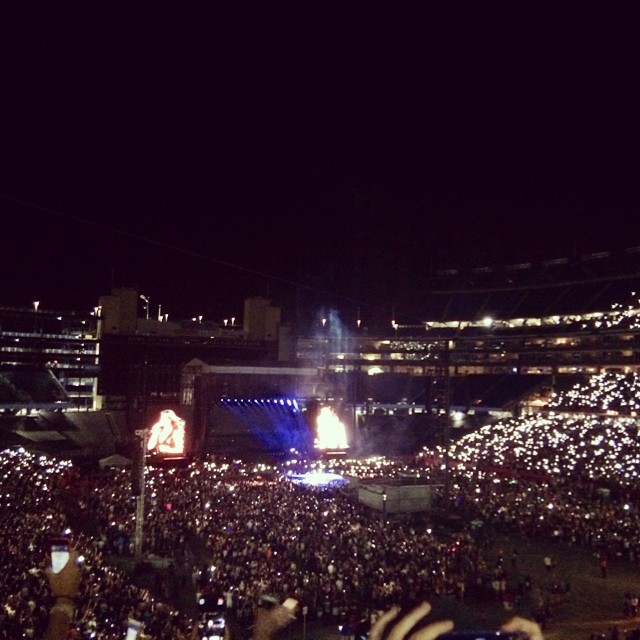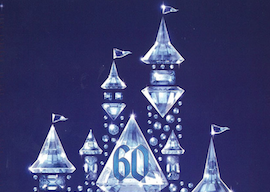What comes to mind when you think about…BEYONCÉ?
Flawless? Talented? Great hair?
Beyoncé and husband Jay Z’s “couple concert” in Boston last week was an epic display of glitz and glam and light and dancing.
It. Was. Awesome.
And yet, because the concert was at Gillette Stadium and because Beyoncé is (according to Forbes) the most powerful person in the entertainment industry, there was also limited parking, terrible food, and impossible crowds.
As I waited in two miles of traffic to approach the road that would lead me to a privately operated lot near Gillette where I was likely—but not guaranteed—to find parking, I found myself surrounded by people who put my fandom to shame. People were wearing Beyoncé look-alike costumes, blasting her music, and getting into verbal cross-car fights about which of her songs is best.
As I waited in line to order a grilled chicken sandwich that would be served to me 25 minutes later and in the form of a turkey burger, I was surrounded by people who were wondering if Beyoncé and Jay Z would kiss on stage, and what this would mean for all of those “he cheated” rumors.
Next, I waited in line to be told that the apparel stand on my side of the stadium had completely run out of female Beyoncé merchandise, I prophesized with my fellow line-mates about whether or not Beyoncé would get more cheers than Jay Z (which she definitely did…and does, in general).
All of this waiting and all of these conversations took place during the two hours we had to wait before the concert began (which was two hours after its scheduled start time).
You might wonder: why am I not writing a scathing review on Gillette Stadium’s Yelp page about their mystery meats and inefficient staffers? Why am I not sending angry emails to the parking people who promised “no exiting lines” and who instead delivered two hours of “exiting lines”? Why am I not starting false rumors about Beyoncé because she made me wait for two hours and didn’t bring along enough female apparel?
Ordinarily, any one of these poor service experiences would be enough for me to swear off chicken sandwiches or parking. Why, then, did I leave the Beyoncé-Jay Z concert humming song after song and wondering if I could buy a Beyoncé wig on Ebay?
As a marketing intern at Continuum—a business that focuses on designing for human experiences—I’m thinking that consumers may associate end results with what an experience promises to deliver. While the smaller service components of a larger service can enhance customer experience, perhaps what we care most about is the end result – so much so that we’re willing to overlook some negative aspects to focus on the overall experience.
Nowhere in Gillette’s marketing does it advertise “The Best Chicken Sandwich In All of Massachusetts”,” or, “The Fastest Off-Site Parking You’ve EVER Seen,” or, “More Beyoncé Apparel Than You Can Wear In An Entire Lifetime.”
All that Gillette Stadium promised me was a concert. And all that Beyoncé promised me was a great concert.
Despite supplying too few women’s tank tops (I forgive you, Bey), Beyoncé certainly followed through on her promise to deliver a spectacle. For two solid hours, she danced around stage, sang her greatest hits, and kept us engaged.

It didn’t matter that I knew one Jay Z song to every ten Beyoncé songs— everything they performed—from “Halo” to “Holy Grail” to “Partition”—was catchy, beautiful, upbeat, and/or iconic.
It also helped that both Beyoncé and Jay Z made efforts to acknowledge their audience and their location. Whenever they spoke, a collective hush fell over the crowd. They constantly asked us, “Are y’all having a good time?” and told us to “show some love.” They even ended some songs with “Boston Strong” declarations—which elicited pride and excitement from the crowd.
Both Beyoncé and Jay Z knew their audience and were able to cater to us throughout the performance. In adding a customer-centric element to their performance, they created a concert community—a community that would disperse after two hours of music and fun, but a community that would associate a great performance with a great experience.
While I will most likely not be recommending Gillette for the Gold Star in sandwich creation, I will not be faulting it for a series of poor service experiences because it was responsible for bringing me the ultimate of service experiences.
That being said, are there some instances where a venue or a business cannot rely on fabulous “final experiences” to satisfy their customers? Under what circumstances is a “holistic service experience” more important than a customer’s eventual state of mind?
Perhaps if Gillette made a point of partnering with the best in food service, or perhaps if it worked with local parking providers to create more efficient “exit strategies,” customers would jump at the chance to attend a Gillette event—not simply because the best in music entertainment was coming to town, but because a Gillette event would guarantee a good experience all around.
I’ve seen this sort of holistic experience arising in move theaters, lately. After several theaters near me decided to renovate their interiors, I now have the option to watch the newest movies in plush, leather recliners, while enjoying a full meal and an adult beverage.
Yes, seeing a good movie is a rewarding experience on its own. But isn’t it better (and more Instagram-able) to enjoy a good movie and feel like royalty while doing it?
If experiences can be richer and more luxurious, then why is a movie theater focusing on experience enhancement while a stadium venue is not?
Catering to people’s values is one way in which some movie theaters have chosen to differentiate themselves. While Gillette is one of just a few venues that connect Beyoncé to her legions of fans, movie theaters are not the only game in town. Viewers usually have several theaters from which to choose, as well as online options (like Netflix). Given all of this competition, theaters need some key element to drive business – creating a luxurious experience is one way to do this.
It’s up to venue providers to decide if they care more about the components of an experience or the results of that experience. Maybe I didn’t need every part of my Beyoncé journey to be the best in service.
But, if every part of a customer’s experiential journey could be the best part, shouldn’t that be the end goal?
Image by anamakingon/ License by CC by 2.0



